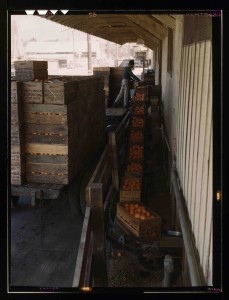I have referred before to my theory of the standard history, the (only partially sarcastic) idea that everything was invented between 1880 and 1910. Fortunately, the history of the Citrus Empire, what later came to be the Inland Empire, follows this pattern quite nicely:
1. Pre-history
Before 1870, you had Spanish and Mexican settlers, Native Americans, Mormon pioneers, the random Anglo gold prospector and so on. But it’s a fuzzy, out-of-focus picture of sparse settlement in a dusty backwater.
2. Invention
In the time of great change, here starting perhaps in 1870s, everything that we understand as foundational to the Inland Empire is laid out. At the beginning of the period, there’s nothing. But by the end, you have railroads linking the region with the rest of the country, irrigation to support a booming economy based around citrus, and established settlements in the form of the citrus colonies of Riverside, Pomona, Ontario, Redlands, Claremont, and so forth. Even the stories that we commonly associate with California — especially the healthy lifestyle and the abundance of the land — were created and propagated during this time. A rough timeline, drawn largely from Douglas Cazaux Sackman’s Orange Empire: California and the Fruits of Eden, looks like this:
1873: “Washington” navel oranges arrive in Riverside
1877: first shipment of oranges from southern California
1882: Santa Fe transcontinental railroad
1886: citrus fair in Chicago
1886: refrigerator cars on the Southern Pacific railroad introduced
1889: 452,000 boxes of citrus shipped
1893: World’s Columbian Exposition in Chicago
1898: Sunset magazine, the “in-flight magazine of the Southern Pacific Railroad” introduced
1899: 6,000,000 boxes of citrus shipped
1907: Citrus Experiment Station, which would be the University of California at Riverside, established
1909: 14,500,000 boxes of citrus shipped
3. All the rest
The third phase, after about 1910, is really just explication; the themes, and the physical infrastructure, were in place and the growth that subsequently happened simply filled in the frame that was drawn in the previous phase. Coincidentally, our house in Redlands was built in 1910, so I can draw an imaginary line from the family that first lived in this house down to my own, and while there have been many changes over that time, the basic patterns — the structures of everyday life — were by that date already in place, I believe.


This theory sounds perhaps to be a corollary to a theory I have been trying to propagate for some time – that ancient history actually does not exist – or is at least far too speculative to be worthy of academicizing….better for myth-making IMHO.
Pingback: » The Great Freeze of 1913 CQ2 | Ed Murphy